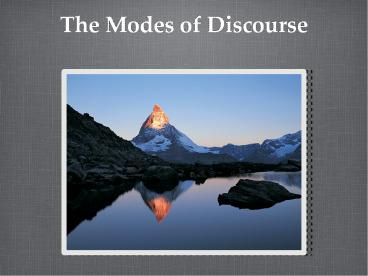The Modes of Discourse - PowerPoint PPT Presentation
Title:
The Modes of Discourse
Description:
The Modes of Discourse Modes of Discourse: Discourse: written or spoken communication or debate Narration Description Process Analysis Exemplification Comparison and ... – PowerPoint PPT presentation
Number of Views:411
Avg rating:3.0/5.0
Title: The Modes of Discourse
1
The Modes of Discourse
2
Modes of DiscourseDiscourse written or spoken
communication or debate
- Narration
- Description
- Process Analysis
- Exemplification
- Comparison and Contrast
- Classification and Division
- Definition
- Cause and Effect
3
Narration
- Refers to telling a story or recounting a series
of events. It can be based on personal
experience or on knowledge gained from reading or
observation. Narration typically includes
concrete details, a point of view, and sometimes
elements of dialogue. - Writers use narration as a way to enter into
their topics
4
Description
- Is closely allied with narration because both use
specific details. However, unlike narration,
description emphasizes the senses by painting a
picture of how something looks, sounds, smells,
tastes, or feels. - Used to establish a mood or atmosphere. A clear
vivid description can make writing more
persuasive.
5
Process Analysis
- Explains how something works, how to do
something, or how something was done. - The key to successful process analysis is
clarity its important to explain a subject
clearly and logically, with transitions that mark
major steps, stages, or phases of the process . - many self help books are essentially process
analysis.
6
Exemplification
- Providing a series of examples--facts, specific
cases, or instances--turns a general idea into a
concrete one this makes your argument both
clearer and more persuasive to a reader.
7
Comparison and/or Contrast
- A common pattern of development is comparison and
contrast juxtaposing two things to highlight
their similarities and differences - Writers use comparison and/or contrast to analyze
information carefully, which often reveals
insights into the nature of the information being
analyzed.
8
Classification and Division
- It is important for readers as well as writers to
be able to sort material or ideas into major
categories. - By answering the question, What goes together
and why? writers and readers can make
connections between things that might otherwise
seem unrelated.
9
Definition
- So many discussions depend upon definition.
Defining a term is often the first step in a
debate or disagreement.
10
Cause and Effect
- Analyzing the cause that lead to a certain effect
or, conversely, the effects that result from a
cause is a powerful foundation for argument. - Since causal analysis depends upon crystal clear
logic, it is important to carefully trace a chain
of cause and effect and to recognize possible
contributing causes.
11
Rhetoric DefinedWhy the negative connotation?































